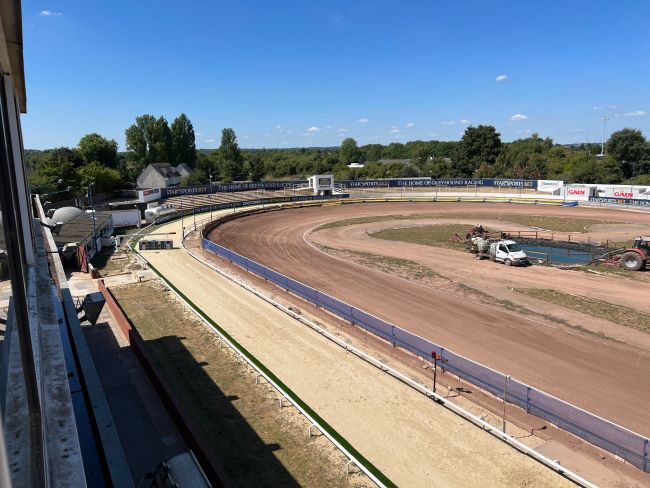Racing tracks for greyhounds significantly vary in their conditions, and these variances can considerably impact the outcomes of the races. Several variables such as track surface, weather, length, configuration, and the state of maintenance all contribute to the overall track conditions, shaping the racing experience for the greyhounds and the spectators.
Track Surface: Sand, Dirt, or Synthetic
There are three primary types of racing surfaces utilized in greyhound racing: sand, dirt, and synthetic.
Sand tracks are commonly used due to their ability to absorb shock, thereby reducing the risk of injury to the dogs. However, they can be heavier to run on, potentially affecting the dogs’ speed and stamina.
Dirt tracks provide for a faster race but are often subject to environmental changes. They can become muddy in wet conditions, challenging the dogs’ dexterity and perhaps affecting the outcome of a race.
Synthetic tracks have gained popularity due to their durability and lower upkeep. These tracks respond less to weather changes, offering consistency. However, their effect on the performance of the dogs is still being evaluated.
Weather Conditions: Control or Variable
The weather also plays a significant role in track conditions. Rain can make the track soggy and muddy, increasing the difficulty for the dogs. In contrast, a dry and hot day might lead to a hard and fast track, favouring dogs with more endurance and speed. However, it’s essential to note that extreme weather conditions will lead to the cancellation of the races for the safety of the dogs.
Track Length and Configuration: More than Just a Circle
The length of a race track and its configuration can vary greatly. Tracks may range from 300 yards to 1100 yards and can be oval or pear-shaped. Longer tracks support dogs with better stamina, while shorter tracks favour dogs with quick bursts of speed. The track configuration also can impact tactics; dogs with good cornering abilities might perform better on pear-shaped tracks.
Maintenance: Consistency is Key
Just like any sports field, greyhound tracks require proper maintenance to ensure consistency for the races and the safety of the dogs. Tracks should be frequently inspected for any possible obstructions or unevenness. The frequency of grooming and watering of the track surface can markedly influence the race, as irregular maintenance can lead to unpredictable track conditions.
The complexity of track conditions in greyhound racing provides a challenging and dynamic environment for the dogs, trainers, and bettors. Understanding these factors is essential for appreciating and strategizing in the fast-paced world of greyhound racing.
The Influence of Track Characteristics on Race Strategy
Racing strategies keenly hinge on the track conditions for a particular race event. Greyhounds, like other athletes, have varying strengths and weaknesses that can be exploited or mitigated by their handlers. Here are few tactical considerations that could be influenced by the track conditions:
- The Draw Position: For tracks with a strong bend or those that are pear-shaped, the draw position can be crucial. Dogs with an ‘inside’ draw might have an advantage as they would have less ground to cover around the curves. This advantage, however, could diminish on a straighter track.
- Competing Dog Characteristics: Greyhounds that are strong and heavy might perform better on softer, sand tracks due to their powerful strides. On the other hand, lighter, more agile dogs might be better suited to harder, faster tracks.
- Track Record: Handlers can study track records to analyze the impact of the track’s characteristics. For instance, if races on a particular track are usually won by dogs displaying excellent stamina, handlers might enter dogs with a similar trait.
- Weather Impact Analysis: Handlers can study the effects of weather changes on their dogs’ performances. Dogs might respond differently to extreme temperatures or wet conditions, and this knowledge can aid in preparation for such situations.
Understanding Track Bias
Track bias refers to trends certain tracks might show due to their specific conditions. These trends could favor dogs with particular characteristics. Therefore, understanding and evaluating track bias could be a valuable asset to form a betting strategy. Track bias could occur due to:
- Track Length: Dogs with inherent stamina advantages could be favored on longer, more demanding tracks. Conversely, sprinters might thrive on shorter courses.
- Track Surface: A soft, sandy track might favor dogs that can maintain a high tempo throughout the race, while a hard, fast track might favor dogs with high speed bursts.
| Track Type | Favoring Characteristics |
|---|---|
| Long Track | High Stamina |
| Short Track | High Speed |
| Sandy Surface | High Tempo and Strength |
| Hard Surface | High Speed and Agility |
The Importance of Track Inspection
Frequent and regular inspections are paramount to maintain the quality of the track and provide a safe racing environment. These inspections are a significant determinant of the track conditions and directly affect the race by:
- Ensuring the track surface is uniform and free from debris or divot.
- Checking that the track watering and grooming processes are performed adequately.
- Guaranteeing that the lure system is functioning correctly without obstruction.
- Making sure that the railings alongside the track are secure and without faults.
By better examining these intricacies and sub-factors within a large subject like track conditions, spectators, bettors, trainers, and handlers can obtain a comprehensive understanding of greyhound racing. A deeper insight not only enriches the sport’s appreciation but also boosts the strategic planning significant in any form of racing.
Straights and Bends: The Impact on Greyhound Performance
The layout of a racing track can be a gamechanger in greyhound races, especially the length of the straights and the tightness of the bends. They do not only add variety to the sport, but they also contribute to the unpredictability and excitement of each race, as they can significantly help or hinder different greyhounds.
Straights – The Sprinter’s Domain
Straights provide the opportunity for greyhounds to attain and sustain their maximum speed. As such, greyhounds with a high top speed and good acceleration often perform better on tracks with longer straights. These attributes allow them to pull away from other dogs once they hit the straight, increasing their chance of winning.
Conversely, dogs that rely primarily on endurance might struggle on longer straights, especially if they are up against a field made up of quicker dogs. Fittingly, dogs with good speed but less stamina might struggle on tracks with shorter straights followed by bends, as they won’t have as much opportunity to exploit their speed.
Bends – A Test of Agility and Stamina
Greyhound tracks feature tight bends that provide a unique set of challenges. Greyhounds need to adjust their speed and direction to navigate the corners efficiently. Dogs with superior dexterity and physical strength excel in these scenarios since they can maintain their speed while changing direction swiftly.
A bend’s tightness can also be a critical factor in race strategy. On tracks with tighter bends, dogs with the inside starting position may have an increased advantage. They can cover less ground by maintaining a position closer to the rail, giving them a strategic edge over the dogs on the outer positions.
Moreover, the presence of multiple tight bends supports the dogs with high endurance, as they need to maintain a higher average speed throughout the race.
Overall, understanding how the length of straight paths and the tightness of bends can impact a greyhound’s performance helps trainers prepare their dogs more effectively and enables spectators and bettors to make more informed decisions. Knowledge of individual greyhound’s strengths, weaknesses, and past performances provides invaluable insights when assessing a race on any specific track design.




